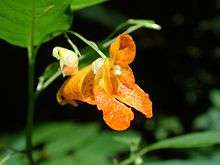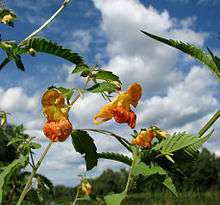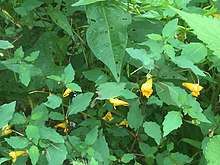Impatiens capensis
Impatiens capensis, the orange jewelweed, common jewelweed, spotted jewelweed,[1] or orange balsam,[2] is an annual plant which is native to eastern North America (but considered invasive in the Pacific Northwest[3]). It is common in bottomland soils, ditches, and along creeks, often growing side-by-side with its less common relative, yellow jewelweed (I. pallida).
| Orange jewelweed | |
|---|---|
 | |
| Scientific classification | |
| Kingdom: | Plantae |
| Clade: | Tracheophytes |
| Clade: | Angiosperms |
| Clade: | Eudicots |
| Clade: | Asterids |
| Order: | Ericales |
| Family: | Balsaminaceae |
| Genus: | Impatiens |
| Species: | I. capensis |
| Binomial name | |
| Impatiens capensis Meerb. | |
| Synonyms | |
|
Impatiens biflora Walter | |
Description

Jewelweed is an herbaceous plant that grows 3 to 5 feet tall and blooms from late spring to early fall. The flowers are orange (sometimes blood orange or rarely yellow) with a three-lobed corolla; one of the calyx lobes is colored similarly to the corolla and forms a hooked conical spur at the back of the flower. Plants may also produce non-showy cleistogamous flowers, which do not require cross-pollination.[4]
It often branches extensively. The round stems are glabrous (smooth) and succulent,[5] and semi-translucent, with swollen or darkened nodes on some plants. The leaves are alternate and simple and have teeth on the margins. The seed pods have five valves which coil back rapidly to eject the seeds in a process called explosive dehiscence.[6] This reaction is where the name 'touch-me-not' comes from; in mature seed pods, dehiscence can easily be triggered with a light touch.
Distribution
Impatiens capensis was transported in the 19th and 20th centuries to England, France, the Netherlands, Poland, Sweden, Finland, and potentially other areas of northern and central Europe. These naturalized populations persist in the absence of any common cultivation by people. This jewelweed species is quite similar to Impatiens noli-tangere, an Impatiens species native to Europe and Asia, as well as the other North American Impatiens. No evidence exists of natural hybrids, although the habitats occupied by the two species are very similar.
Medicinal use
Along with other species of jewelweed, the juice of the leaves and stems is a traditional Native American remedy for skin rashes, including poison ivy.[7] The effectiveness of its use to prevent the development of a rash after short-term exposure to poison ivy has been supported by peer-reviewed study, and is likely due to the plant containing saponins.[8][9] These studies also found that some individuals have a sensitivity to jewelweed which can cause a more severe rash.
The stem juice has also been used to treat athlete's foot; its fungicidal qualities have been scientifically verified.[10]
Etymology
The leaves appear to be silver or 'jeweled' when held underwater, which is possibly where the jewelweed name comes from. Another possible source of the name is the color and shape of the bright robin's egg-blue kernels of the green projectile seeds.
The species name capensis, meaning "of the cape", is actually a misnomer, as Nicolaas Meerburgh was under the mistaken impression that it was native to the Cape of Good Hope, in southern Africa.[11]
Pollination

Nectar spurs are tubular elongations of petals and sepals of certain flowers that usually contain nectar. Flowers of Impatiens capensis have these nectar spurs. Nectar spurs are thought to have played a role in plant-pollinator coevolution. Curvature angles of nectar spurs of Impatiens capensis are variable. This angle varies from 0 degrees to 270 degrees.[12]
The angle of the nectar spur is very important in the pollination of the flower and in determining the most efficient pollinator. Hummingbirds are major pollinators. They remove more pollen per visit from flowers with curved nectar spurs than with perpendicular nectar spurs.[12] But hummingbirds are not the only pollinators of Impatiens capensis. Bees, especially bumblebees play an important role in pollination as well. Due to hummingbirds and bees, the pollination of Impatiens capensis is very high.[13]
Gallery
 Leaves and flowers
Leaves and flowers Jewelweed growing on a creek side
Jewelweed growing on a creek side Flower
Flower_along_a_walking_path_in_the_Franklin_Farm_section_of_Oak_Hill%2C_Fairfax_County%2C_Virginia.jpg) Leaf showing beads (jewels) just after rain
Leaf showing beads (jewels) just after rain
References
- Dickinson, T.; Metsger, D.; Bull, J.; Dickinson, R. (2004). ROM Field Guide to Wildflowers of Ontario. Toronto: Royal Ontario Museum and McClelland and Stewart Ltd. p. 197.
- "BSBI List 2007". Botanical Society of Britain and Ireland. Archived from the original (xls) on 2015-01-25. Retrieved 2014-10-17.
- Ceska, Dr. A. (21 April 2009). "Botanical Electronic News, No. 408". Retrieved 15 June 2020.
- Hilty, John (2016). "Orange Jewelweed (Impatiens capensis)". Illinois Wildflowers.
- "Orange Jewelweed (Impatiens capensis)". www.illinoiswildflowers.info.
- Hayashi, Marika; Feilich, Kara; Ellerby, David (May 2009). "The mechanics of explosive seed dispersal in orange jewelweed (Impatiens capensis)". Journal of Experimental Botany. 60 (7): 2045–2046. doi:10.1093/jxb/erp070. PMC 2682495. PMID 19321647.
- Smith, Huron H. (1933). "Ethnobotany of the Forest Potawatomi Indians". Bulletin of the Public Museum of the City of Milwaukee. 7: 42.
- Motz, Vicki; Bowers, Christopher; Kneubehl, Alexander; Lendrum, Elizabeth; Young, Linda; Kinder, David (2015). "Efficacy of the saponin component of Impatiens capensis Meerb. in preventing urushiol-induced contact dermatitis". Journal of Ethnopharmacology. 162: 163-167. doi:10.1016/j.jep.2014.12.024.
- Motz; Bowers; Young; Kinder (2012). "The effectiveness of jewelweed, Impatiens capensis, the related cultivar I. balsamina and the component, lawsone in preventing post poison ivy exposure contact dermatitis". Journal of Ethnopharmacology. 143 (1): 314–318. doi:10.1016/j.jep.2012.06.038. PMID 22766473.
- Niering, William A.; Olmstead, Nancy C. (1985) [1979]. The Audubon Society Field Guide to North American Wildflowers, Eastern Region. Knopf. p. 414. ISBN 0-394-50432-1.
- Strausbaugh, P.D.; Core, E. L. (1964). Flora of West Virginia (2nd ed.). Seneca Books. p. 622. ISBN 978-0-89092-010-7.
- Travers, Steven E; Temeles, Ethan J; Pan, Irvin (2003). "The relationship between nectar spur curvature in jewelweed (Impatiens capensis) and pollen removal by hummingbird pollinators". Canadian Journal of Botany. 81 (2): 164–70. doi:10.1139/b03-014.
- Elemans, Marjet (2004). "Light, nutrients and the growth of herbaceous forest species". Acta Oecologica. 26 (3): 197–202. Bibcode:2004AcO....26..197E. doi:10.1016/j.actao.2004.05.003.
External links
| Wikiversity has bloom time data for Impatiens capensis on the Bloom Clock |
| Wikimedia Commons has media related to Impatiens capensis. |
| Wikispecies has information related to Impatiens capensis |